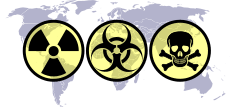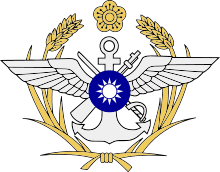Taiwan and weapons of mass destruction
Taiwan denies having any weapons of mass destruction. There is no evidence of it possessing any chemical, biological, or nuclear weapons, although it has pursued nuclear weapons in the past.[1]
| Weapons of mass destruction |
|---|
 |
| By type |
| By country |
|
| Proliferation |
| Treaties |
|
Nuclear weapons
Research program
The development of nuclear weapons by the Republic of China has been a contentious issue, as it had been triggered by PRC's first nuclear test in 1964.[2] The U.S., hoping to avoid escalating tensions in the Taiwan Strait, has continually opposed arming the Republic of China with nuclear weapons after 1979. Accordingly, the Republic of China adheres to the principles of the nuclear Non-Proliferation Treaty and has stated that it does not intend to produce nuclear weapons, on an official basis. Past nuclear research by the ROC makes it a "threshold" nuclear state.
In 1967, a nuclear weapons program began under the auspices of the Institute of Nuclear Energy Research (INER) at the Chungshan Institute of Science and Technology. The Republic of China was able to acquire nuclear technology from abroad (including a research reactor from Canada and low-grade plutonium from the United States) allegedly for a civilian energy system, but in actuality to develop fuel for nuclear weapons.[3]
During the 1970s, the Republic of China had an active program to produce plutonium using heavy water reactors. However, after the International Atomic Energy Agency found evidence of the Republic of China's efforts to produce weapons-grade plutonium, Taipei agreed in September 1976 under U.S. pressure to dismantle its nuclear weapons program.[4] A study by the Mitre Corporation in 1977 included Taiwan in a list of "insecure" nuclear threshold states—states with the technical capability to develop nuclear weapons and the security motivations to seriously contemplate such an option. The other states were Israel, South Africa, South Korea, and Yugoslavia.[5] U.S. intelligence believed that the Republic of China also had designed devices suitable for nuclear testing.[6]
A secret program was revealed when Colonel Chang Hsien-yi, deputy director of nuclear research at INER who was secretly working for the CIA, defected to the U.S. in December 1987 and produced a cache of incriminating documents. General Hau Pei-tsun claimed that scientists in Taiwan had already produced a controlled nuclear reaction. Under pressure from the U.S., the program was halted. A study into the secret program concluded that at the time of Chang's defection, Taiwan was one or two years away from being able to complete a nuclear bomb.[1] In 1987 the warhead design had a diameter of 60-70cm with casing and a weight of 900kg meaning that further miniaturization would have been needed to optimize the weapon for delivery.[7]
During the 1995–1996 Taiwan Strait crisis, then Republic of China President Lee Teng-hui proposed to reactivate the program, but turned down the rhetoric a few days later, saying that although Taiwan was nuclear latent, it "will definitely not" produce nuclear weapons.[8]
Delivery systems
The Sky Horse ballistic missile system was developed in the late 1970s and early 1980s before a combination of pressure from American President Ronald Reagan and internal competition from anti-ballistic missile development programs ended the program in 1982. Faced with an inability to field their desired delivery system planners turned to alternatives.[7]
The secondary delivery vehicle was the AIDC F-CK-1 Ching-kuo, then in development. Weapons designers at CSIST were instructed to design the nuclear weapon to fit within the dimensions of the F-CK-1’s centerline drop tank (~50cm diameter). Modifications to the aircraft would have been required for it to obtain the desired 1,000km range (especially without the centerline drop tank available). The F-CK-1 would not have been able to fulfill the nuclear strike mission until mid-1989 at the very earliest. Early designs called for an unpowered gravity bomb.[7]
Current status
There is no evidence that the ROC possesses any nuclear weapons or any programs to produce them, although it does have the advanced, state of the art technological ability to develop nuclear weapons as well as the high-tech ability to enrich uranium or process plutonium.[8] The Republic of China's nuclear power plants use imported enriched uranium and are subject to International Atomic Energy Agency inspection.
Chemical weapons
The Republic of China may be in possession of small quantities of sarin. However, the Republic of China government has stated that any such materials are only for defensive research purposes and that it does not have any intention of producing offensive chemical weapons.
Ratification of international treaties
The Republic of China ratified the Geneva Protocol on August 7, 1929, and the Nuclear Non-Proliferation Treaty (NPT) in 1970 before PRC entered the UN. Following UN General Assembly Resolution 2758 (1971) the United Nations does not recognize the Republic of China as a legitimate political entity, and as such does not recognize any right that the ROC has to join international multilateral treaties. Because of its controversial political status, the ROC has not been allowed to join either the Biological Weapons Convention nor the Chemical Weapons Convention, but it has stated that it will abide by both treaties nevertheless. In addition, the ROC has stated that it will continue to abide by the NPT, notwithstanding Resolution 2758.[9] The ROC was one of the original members of the NPT in 1968. After the People’s Republic of China replaced the ROC at the United Nations in 1971, in effect Taiwan ceased to be active as a participating party to the official NPT activities. However, it signed a trilateral agreement with the United States and the IAEA in 1971 stating that it would continue to abide by the terms of the NPT as a ratification party. While not a member of the IAEA, Taiwan does continue to subscribe to the IAEA’s safeguards under two agreements, INFCIRC/133 and INFCIRC/158.[10]
See also
References
- Weiner, Tim (20 December 1997). "How a Spy Left Taiwan in the Cold" – via NYTimes.com.
- "1964: China's first atomic bomb explodes". China.org.cn. Retrieved 2017-02-07.
- Roy, Denny (2003). Taiwan: A Political History. Cornell University Press. ISBN 0-8014-8805-2.
- Ide, William (14 October 1999). "How the US stopped Taiwan's bomb". Taipei Times. Retrieved 26 November 2016.
- Report of the Nuclear Energy Policy Study Group, Nuclear Power Issues, and Choices (Cambridge, MA: Ballinger Publishing Co., 1977), p. 284.
- "The 22 September 1979 Event" (PDF). Interagency Intelligence Memorandum. National Security Archive. December 1979. p. 5 (paragraph 4). MORI DocID: 1108245. Retrieved 2006-11-01.
- ANDREA STRICKER, DAVID ALBRIGHT AND (2018). TAIWAN’S FORMER NUCLEAR WEAPONS PROGRAM (PDF). institute for science and international security. ISBN 1727337336. Retrieved 5 August 2019.
- Albright, David; Gay, Corey (1 January 1998). "Taiwan: Nuclear nightmare averted". Bulletin of the Atomic Scientists. Archived from the original on 27 February 2011. Retrieved 18 May 2015 – via HighBeam Research.
- "Show Action". Disarmament.un.org. Retrieved 2017-02-07.
- "Spreadsheet" (PDF). www.nti.org.
